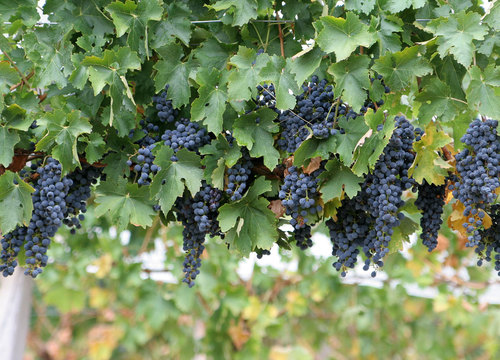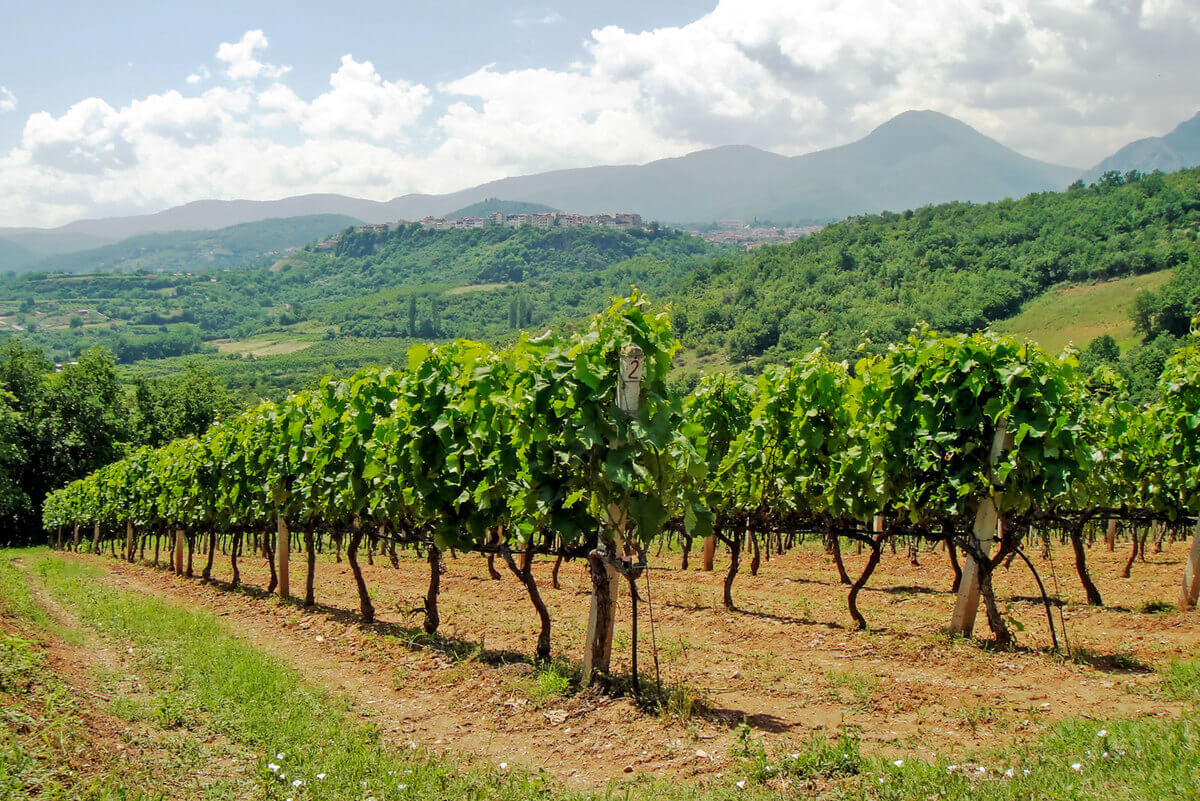The variety used for winemaking is mainly Xinomavro and, at a smaller percentage, those of Roditis, Syrah and Merlot.
Xinomavro
A noble, indigenous variety, which dominates Northern Greece, mainly found within the boundaries of the imaginary triangle formed by the towns of Naoussa, Amynteo and Goumenissa. It was also known with the names Mavro Naoussis or Niaoustiano, Mavro Goumenissas, Mavro Xino, Popolka, Xinomavro Kozanis but finally the name Xinomavro has prevailed.
The plants are vigorous, productive, in linear vineyards and allow of short pruning. According to legislation, authorized yield should not exceed 10.000 kgr per hectare in order to produce wines that are assigned an Appellation of Origin. It is relatively susceptible to peronosporos and oidium. Moreover, serious damage can be caused by votrytis cinerea, which can affect plants if favourable weather conditions occur. Bunches are easy to pick, which makes an effortless vintage. However, stems can easily break in case of windy weather or in geographical areas struck by high winds.
Its versatility makes it ideal for a wide range of wine types: red, white, rose. The name Xinomavro is a conjunction and derives from the Greek words for "acid" and "black" which refer to the grape's inherent high acidity and dark colour. The above characteristics combined with the method of vinification and ageing, can produce exceptional wines with a sophisticated personality.
It is used by 100% for the production of the following wines, which are assigned an Appellation of Origin: NAOUSSA V.Q.P.R.D. Aged in French oak barrels for one year NAOUSSA RESERVE V.Q.P.R.D. Aged in casks for one year and in bottles for another two years NAOUSSA GRANDE RESERVE V.Q.P.R.D. Aged in casks for two years and in bottles for, at least, two years DAMASKINOS V.Q.P.R.D. Aged in new, French oak casks with high toasting Xinomavro is also used by 50% for the production of IMEROS Red, Regional Wine of Macedonia. Some white wines are also made from Xinomavro, bearing excellent characteristics, such as DOGMATIKOS White Dry and IMEROS White, Regional Wine of Imathia. Finally, due to its versatility, it can be used for the production of rose wines, such as SALAMMBO and VAENI ROSE DEMI-SEC.
Roditis
Roditis has been cultivated in our country from the very old times. It is a vigorous and relatively productive variety that can be met in many clone variations, bearing from white to deep red berries. Relatively susceptible to peronosporos and some viruses, it also appears to shed its buds during high vigor conditions. Vines are developed linear and allow of short pruning. It can produce fine, well-balanced, refreshing wines with a delicate aroma.
Syrah
The Syrah variety, which is subjected to red wine vinification, has become known for the superb red wines it yields. It is vibrant and productive in linear vineyards, which are developed at double lanyard. It is relatively sensitive to gray rot and drought during its vegetative circle. Also delicate when relatively high winds prevail and young clusters/shoots have to be secured on the wires, as they tend to break easily. The grapes ripen within a short time and therefore require meticulous attendance during that period of time, as they can easily over ripe.
Wines are richly coloured and laced with a distinctive, seductive aroma that is getting even more complex through bottle ageing. Syrah is used by a 50% proportion for the production of Imeros Red and by 100% for the mono-varietal Syrah Regional Wine of Macedonia.
Merlot
A French variety with great appeal in Greece. It appears to be sensitive to dry weather, it requires well-irrigated soils during its vegetative circle and emergency irrigation should be applied whenever necessary. At the beginning of its vegetative circle, early bud-break is noted, which makes it vulnerable to spring-frost. A significant drawback of this variety is its tendency to shed its buds. This problem can be dealt with different ways of pruning and nipping off the heads. Wines are richly coloured, robust with a velvety taste and long aftertaste. It can be used as an "improving" variety, to enhance the colour and aroma of other varieties as well as speed up the ageing.






